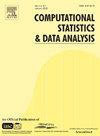Functional time transformation model with applications to digital health
IF 1.6
3区 数学
Q3 COMPUTER SCIENCE, INTERDISCIPLINARY APPLICATIONS
引用次数: 0
Abstract
The advent of wearable and sensor technologies now leads to functional predictors which are intrinsically infinite dimensional. While the existing approaches for functional data and survival outcomes lean on the well-established Cox model, the proportional hazard (PH) assumption might not always be suitable in real-world applications. Motivated by physiological signals encountered in digital medicine, we develop a more general and flexible functional time-transformation model for estimating the conditional survival function with both functional and scalar covariates. A partially functional regression model is used to directly model the survival time on the covariates through an unknown monotone transformation and a known error distribution. We use Bernstein polynomials to model the monotone transformation function and the smooth functional coefficients. A sieve method of maximum likelihood is employed for estimation. Numerical simulations illustrate a satisfactory performance of the proposed method in estimation and inference. We demonstrate the application of the proposed model through two case studies involving wearable data i) Understanding the association between diurnal physical activity pattern and all-cause mortality based on accelerometer data from the National Health and Nutrition Examination Survey (NHANES) 2011-2014 and ii) Modelling Time-to-Hypoglycemia events in a cohort of diabetic patients based on distributional representation of continuous glucose monitoring (CGM) data. The results provide important epidemiological insights into the direct association between survival times and the physiological signals and also exhibit superior predictive performance compared to traditional summary-based biomarkers in the CGM study.
功能时间转换模型及其在数字健康中的应用
可穿戴和传感器技术的出现,现在导致了本质上无限维度的功能预测器。虽然现有的功能数据和生存结果的方法依赖于完善的Cox模型,但比例风险(PH)假设可能并不总是适用于实际应用。在数字医学中遇到的生理信号的激励下,我们开发了一个更通用和灵活的函数时间变换模型,用于估计具有函数和标量协变量的条件生存函数。采用部分泛函回归模型,通过未知的单调变换和已知的误差分布,直接对协变量的生存时间进行建模。利用Bernstein多项式对单调变换函数和光滑泛函系数进行建模。采用极大似然筛法进行估计。数值仿真结果表明,该方法具有较好的估计和推理性能。我们通过涉及可穿戴数据的两个案例研究展示了所提出模型的应用:i)基于2011-2014年国家健康与营养调查(NHANES)的加速度计数据,了解每日身体活动模式与全因死亡率之间的关系;ii)基于连续血糖监测(CGM)数据的分布表示,对糖尿病患者队列中的低血糖事件进行建模。该结果为生存时间与生理信号之间的直接关联提供了重要的流行病学见解,并且与传统的基于摘要的生物标志物相比,在CGM研究中表现出优越的预测性能。
本文章由计算机程序翻译,如有差异,请以英文原文为准。
求助全文
约1分钟内获得全文
求助全文
来源期刊

Computational Statistics & Data Analysis
数学-计算机:跨学科应用
CiteScore
3.70
自引率
5.60%
发文量
167
审稿时长
60 days
期刊介绍:
Computational Statistics and Data Analysis (CSDA), an Official Publication of the network Computational and Methodological Statistics (CMStatistics) and of the International Association for Statistical Computing (IASC), is an international journal dedicated to the dissemination of methodological research and applications in the areas of computational statistics and data analysis. The journal consists of four refereed sections which are divided into the following subject areas:
I) Computational Statistics - Manuscripts dealing with: 1) the explicit impact of computers on statistical methodology (e.g., Bayesian computing, bioinformatics,computer graphics, computer intensive inferential methods, data exploration, data mining, expert systems, heuristics, knowledge based systems, machine learning, neural networks, numerical and optimization methods, parallel computing, statistical databases, statistical systems), and 2) the development, evaluation and validation of statistical software and algorithms. Software and algorithms can be submitted with manuscripts and will be stored together with the online article.
II) Statistical Methodology for Data Analysis - Manuscripts dealing with novel and original data analytical strategies and methodologies applied in biostatistics (design and analytic methods for clinical trials, epidemiological studies, statistical genetics, or genetic/environmental interactions), chemometrics, classification, data exploration, density estimation, design of experiments, environmetrics, education, image analysis, marketing, model free data exploration, pattern recognition, psychometrics, statistical physics, image processing, robust procedures.
[...]
III) Special Applications - [...]
IV) Annals of Statistical Data Science [...]
 求助内容:
求助内容: 应助结果提醒方式:
应助结果提醒方式:


